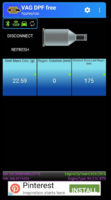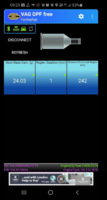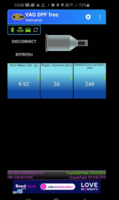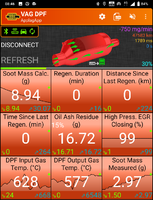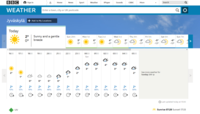DPF Regen, Yellow light & AdBlue - Whats it all about? -
The DFP light is becoming a more apparent issue with modern diesel vans, unfortunately, it’s a fact of modern diesel life.
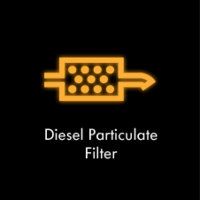
what is a DPF?
Diesel particulate filters (DPF) are very effective in cutting emissions, trapping even the finest soot particles produced as the engine burns diesel fuel.
Their lifespan is dependent on factors such as fuel quality, driving style, use and oil consumption. The filter uses a catalytic coating containing precious metals. Passive regeneration converts the particulate matter contained in the catalytic converter into CO2. This process takes place at temperatures between 350 and 500°C and can run continuously, particularly if you drive your car mainly on long runs.
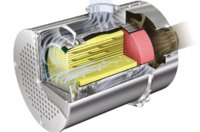
.
What causes a diesel particulate filter blockage?
Short journeys at low speeds are the prime cause of blocked diesel particulate filters.
This is why van makers often go as far as recommending city-bound short-hop drivers choose a petrol car instead of diesel (and it’s why diesels are something of a rarity in the city car sector).
Other things that are bad for DPFs include poor servicing. A diesel particulate filter on a poorly serviced car may fail sooner than a well maintained one, generally, they should last for at least 100,000 miles.
It’s important you use the right type of oil as well – some oils contain additives that can actually block filters.
.

.
The best way to maintain a DPF is to make sure it’s fully able to regenerate itself when it’s full of soot (when the warning light appears).
There are two types of regeneration: passive and active.
Passive regeneration
Passive regeneration occurs when the car is running at speed on long motorway journeys which allow the exhaust temperature to increase to a higher level and cleanly burn off the excess soot in the filter.
So it is advised that drivers regularly give their diesel vehicle a good 30 to 50 minute run at sustained speed on a motorway or A-road to help clear the filter.
However, not all drivers do this type of driving regularly – which is why manufacturers have designed an alternative form of regeneration.
Active regeneration
Active regeneration means extra fuel is injected automatically, as part of the vehicle's ECU, when a filter reaches a predetermined limit (normally about 45%) to raise the temperature of the exhaust and burn off the stored soot.
Problems can occur, however, if the journey is too short, as the regeneration process may not complete fully.
If this is the case the warning light will continue to show the filter is still partially blocked.
In which case it should be possible to complete a regeneration cycle and clear the warning light by driving for 10 minutes or so at speeds greater than 40mph.
You will know whether active regeneration is taking place by the following symptoms:
If your warning light continues to stay on, turns red, or additional DPF lights come on, do not leave it too long before getting it checked out.
More damage can be caused this way and what could be an inexpensive fix can become something much more expensive.
Some garages can clean blocked DPFs, in a process called forced regeneration.
This usually costs around £100 and, while it’s not a 100% guaranteed fix, it’s usually successful in removing the excess soot and allowing the DPF to work and automatically regenerate again.
It’s a failure to correctly regenerate that is the cause of most diesel particulate filter issues: they become blocked, which increases exhaust emissions, stifles engine performance and sometimes even puts the engine into a restricted ‘limp-home mode’.
On some models the engine may not restart after a number of miles – again, consult your handbook for details.
I make lots of short journeys, how will this affect my DPF?
The particles are trapped on the walls of the DPF, stored and continually disposed of. We call this process 'regeneration'. The DPF system needs the car to be driven at a constant road speed so the regeneration process can be completed successfully. Lots of short journeys, and trips that involve stop/start traffic, may cause the regeneration cycle to be unsuccessful. A single, longer journey may be all that is required for regeneration to be successfully completed.
If your typical driving profile involves short trips in heavy traffic, you may wish to reconsider your choice of car, and may prefer to choose either an electric or hybrid model or one with a small petrol engine instead. - the easy solution to all of this is just to take the van for a long run up the motorway every now and again. Or when the warning light comes on.
.
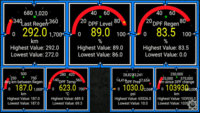
what to do now? - here is the official VW word (DPF LIGHT):
Roadside assistance: 0870 333 0475
1) How many warning lights are on?
One: go to step 2
More than one: Please contact roadside assistance on 0870 333 0475
2. Is the fuel low warning light on?
Yes: The light is on. Refuel the vehicle and go to step 3.
No: The light is not on. Go to step 3.
3. Drive at least 60Km/hr @ engine speed between 1800-2500rpm, at least 15 minutes until light goes out. (Automatic; Select Sport) Did the light go out?
Yes: The light did go out. Filter successfully regenerated.
No: Go to step 4.
4. Can you take the vehicle to your closest authorised repairer?
Yes: If you can take your vehicle, drive safely.
No: If you cant take your vehicle, please contact roadside assistance on 0870 333 0475
source: Diesel Particulate Filter Warning Light | Yellow | Volkswagen UK
A static service regen just uses more fuel and takes longer.... it's better to just go for a drive and enjoy the ride =)
Adblue . . . . what is it?
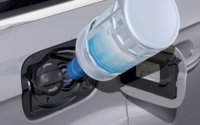
One of the latest techniques used to clean up diesel emissions is known as selective catalytic reduction (SCR). A solution of urea in water is used to treat exhaust gases and remove harmful pollutants, including nitrogen oxides (NOx), of which nitrogen dioxide (NO2) is the most harmful.
The fluid used in most vehicles is known as AdBlue, a registered trademark owned by the German Association of the Automobile Industry (VDA), which ensures standards are maintained. The fluid is stored in a tank in the car, but unlike petrol or diesel it is not injected into the engine; instead it is fed into part of the vehicle’s exhaust. A chemical reaction converts the harmful NOx exhaust gases into harmless nitrogen and water.
Is it safe to drive with the AdBlue warning on?
It’s not a major safety issue, but if you don’t top up, you’ll eventually run out of AdBlue and you won’t be able to start the van.
When the warning light first comes on you’ll have plenty of time to refill – so don’t panic. Just make sure you don’t put off topping up. - just fill with the required amount & dont over fill the tank!
Also, remember when filling with AdBlue....
Before you start the engine....
Switch the ignition ON and ** WAIT ** !!!! ........
For 30 or so seconds until the dash MFI registers the new AdBlue amount.
Once the new value/range is shown...
Then you can Start the engine..
This helps with the miss reading AdBlue problem, failure to do this will result in the problem above of the system not reading the refilled amount.
T6 Owners Manual: (Behold the Book Of Knowledge)
T6 Owners Manual
Page 346 people . . . . . .

Adblue related issues are known to bring up the MIL engine light (the money light !)
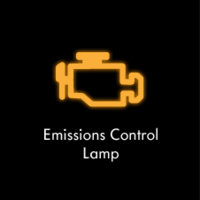
Heres VW office take on this light . . . (Engine emissions light)
1. Does the lamp flash or light permanently?
Permanently: Remove the key for 30 seconds then refit and start the engine. Go to step 2.
Flash: Go to step 2.
2. Is the vehicle vibrating and down on power?
Yes: Contact roadside assistance.
No: Go to step 3.
3. Can you take it to an authorised repairer safely?
Yes: Take caution while driving to an authorised repairer.
No: Please contact roadside assistance on 0870 333 0475
But you can get an idea of the problem yourself by reading the fault codes, you can use VCDS, Carista or others to read the fault codes and google them. Emissions lights can be due to EGU, SCR, Adblue and many other things . . . . . so its a good idea to arm yourself with some back ground knowledge before panicking and hitting the dealers . . . .
*****************************************************
Links for your info:
Car Warning Lights | Volkswagen UK
Diesel Particulate Filter Warning Light | Yellow | Volkswagen UK
Recharge AdBlue Warning Light | Yellow | Volkswagen UK
What Volkswagen Dashboard Lights Mean | Warning Icons & Symbols
*****************************************************
reported VW T6F answers:
@DerekFKS85 (emissions light) Van back. They say it’s an adblue issue but there’s no fault logged, so how do they know?? I’ve to drive it as normal to see if it the light comes on again. If it does it’s going in for a ‘few’ days and they’ll supply a replacement van. Let’s see.
@Neil Nicholls (emissions light) I had a similar issue, and mine was the EGR valve. Mines at nearly 50k, 204 engine, Had the light come up, and Vw assist came out, cleared the fault, but it was back within a week.
The dealer agreed the Egr needed replacing, and had my van in for a week, because they had issues with it !
Picked it up, fault still showed.
@Tony Morris : Just had a similar issue, yellow engine management light illuminated. Carista came up with fault code P154B so contacted VW Assist who have confirmed the problem is a faulty DPF pressure sensor. Due to be replaced tomorrow I'll see if it solves the problem.
@Ashypants : 15560 - EGR Sensor 1 - P046C 00 [108] - Implausible Signal - Intermittent...
Update having been into Sheffield Van Centre - EGR valve - VW are aware but won’t do anything until engine management light comes on.....hmm. - Actuator Stuck - known issue will be fixed with a “software update”
*****************************************************
Carista - How I Done It -
Vcds / Vagcom - How I Done It -
T6 Service Intervals & Inspection, Flexible & Longlife
Dellmassive`s -- "how I Done It" -- Thread
**********************************************
The DFP light is becoming a more apparent issue with modern diesel vans, unfortunately, it’s a fact of modern diesel life.

what is a DPF?
Diesel particulate filters (DPF) are very effective in cutting emissions, trapping even the finest soot particles produced as the engine burns diesel fuel.
Their lifespan is dependent on factors such as fuel quality, driving style, use and oil consumption. The filter uses a catalytic coating containing precious metals. Passive regeneration converts the particulate matter contained in the catalytic converter into CO2. This process takes place at temperatures between 350 and 500°C and can run continuously, particularly if you drive your car mainly on long runs.

.
What causes a diesel particulate filter blockage?
Short journeys at low speeds are the prime cause of blocked diesel particulate filters.
This is why van makers often go as far as recommending city-bound short-hop drivers choose a petrol car instead of diesel (and it’s why diesels are something of a rarity in the city car sector).
Other things that are bad for DPFs include poor servicing. A diesel particulate filter on a poorly serviced car may fail sooner than a well maintained one, generally, they should last for at least 100,000 miles.
It’s important you use the right type of oil as well – some oils contain additives that can actually block filters.
.

.
The best way to maintain a DPF is to make sure it’s fully able to regenerate itself when it’s full of soot (when the warning light appears).
There are two types of regeneration: passive and active.
Passive regeneration
Passive regeneration occurs when the car is running at speed on long motorway journeys which allow the exhaust temperature to increase to a higher level and cleanly burn off the excess soot in the filter.
So it is advised that drivers regularly give their diesel vehicle a good 30 to 50 minute run at sustained speed on a motorway or A-road to help clear the filter.
However, not all drivers do this type of driving regularly – which is why manufacturers have designed an alternative form of regeneration.
Active regeneration
Active regeneration means extra fuel is injected automatically, as part of the vehicle's ECU, when a filter reaches a predetermined limit (normally about 45%) to raise the temperature of the exhaust and burn off the stored soot.
Problems can occur, however, if the journey is too short, as the regeneration process may not complete fully.
If this is the case the warning light will continue to show the filter is still partially blocked.
In which case it should be possible to complete a regeneration cycle and clear the warning light by driving for 10 minutes or so at speeds greater than 40mph.
You will know whether active regeneration is taking place by the following symptoms:
- Engine note change
- Cooling fans running
- A slight increase in fuel consumption
- Increased idle speed
- Deactivation of automatic Stop/Start
- A hot, acrid smell from the exhaust
If your warning light continues to stay on, turns red, or additional DPF lights come on, do not leave it too long before getting it checked out.
More damage can be caused this way and what could be an inexpensive fix can become something much more expensive.
Some garages can clean blocked DPFs, in a process called forced regeneration.
This usually costs around £100 and, while it’s not a 100% guaranteed fix, it’s usually successful in removing the excess soot and allowing the DPF to work and automatically regenerate again.
It’s a failure to correctly regenerate that is the cause of most diesel particulate filter issues: they become blocked, which increases exhaust emissions, stifles engine performance and sometimes even puts the engine into a restricted ‘limp-home mode’.
On some models the engine may not restart after a number of miles – again, consult your handbook for details.
I make lots of short journeys, how will this affect my DPF?
The particles are trapped on the walls of the DPF, stored and continually disposed of. We call this process 'regeneration'. The DPF system needs the car to be driven at a constant road speed so the regeneration process can be completed successfully. Lots of short journeys, and trips that involve stop/start traffic, may cause the regeneration cycle to be unsuccessful. A single, longer journey may be all that is required for regeneration to be successfully completed.
If your typical driving profile involves short trips in heavy traffic, you may wish to reconsider your choice of car, and may prefer to choose either an electric or hybrid model or one with a small petrol engine instead. - the easy solution to all of this is just to take the van for a long run up the motorway every now and again. Or when the warning light comes on.
.

what to do now? - here is the official VW word (DPF LIGHT):
Roadside assistance: 0870 333 0475
1) How many warning lights are on?
One: go to step 2
More than one: Please contact roadside assistance on 0870 333 0475
2. Is the fuel low warning light on?
Yes: The light is on. Refuel the vehicle and go to step 3.
No: The light is not on. Go to step 3.
3. Drive at least 60Km/hr @ engine speed between 1800-2500rpm, at least 15 minutes until light goes out. (Automatic; Select Sport) Did the light go out?
Yes: The light did go out. Filter successfully regenerated.
No: Go to step 4.
4. Can you take the vehicle to your closest authorised repairer?
Yes: If you can take your vehicle, drive safely.
No: If you cant take your vehicle, please contact roadside assistance on 0870 333 0475
source: Diesel Particulate Filter Warning Light | Yellow | Volkswagen UK
A static service regen just uses more fuel and takes longer.... it's better to just go for a drive and enjoy the ride =)
Adblue . . . . what is it?

One of the latest techniques used to clean up diesel emissions is known as selective catalytic reduction (SCR). A solution of urea in water is used to treat exhaust gases and remove harmful pollutants, including nitrogen oxides (NOx), of which nitrogen dioxide (NO2) is the most harmful.
The fluid used in most vehicles is known as AdBlue, a registered trademark owned by the German Association of the Automobile Industry (VDA), which ensures standards are maintained. The fluid is stored in a tank in the car, but unlike petrol or diesel it is not injected into the engine; instead it is fed into part of the vehicle’s exhaust. A chemical reaction converts the harmful NOx exhaust gases into harmless nitrogen and water.
Is it safe to drive with the AdBlue warning on?
It’s not a major safety issue, but if you don’t top up, you’ll eventually run out of AdBlue and you won’t be able to start the van.
When the warning light first comes on you’ll have plenty of time to refill – so don’t panic. Just make sure you don’t put off topping up. - just fill with the required amount & dont over fill the tank!
Also, remember when filling with AdBlue....
Before you start the engine....
Switch the ignition ON and ** WAIT ** !!!! ........
For 30 or so seconds until the dash MFI registers the new AdBlue amount.
Once the new value/range is shown...
Then you can Start the engine..
This helps with the miss reading AdBlue problem, failure to do this will result in the problem above of the system not reading the refilled amount.
T6 Owners Manual: (Behold the Book Of Knowledge)
T6 Owners Manual
Page 346 people . . . . . .
Adblue related issues are known to bring up the MIL engine light (the money light !)

Heres VW office take on this light . . . (Engine emissions light)
1. Does the lamp flash or light permanently?
Permanently: Remove the key for 30 seconds then refit and start the engine. Go to step 2.
Flash: Go to step 2.
2. Is the vehicle vibrating and down on power?
Yes: Contact roadside assistance.
No: Go to step 3.
3. Can you take it to an authorised repairer safely?
Yes: Take caution while driving to an authorised repairer.
No: Please contact roadside assistance on 0870 333 0475
But you can get an idea of the problem yourself by reading the fault codes, you can use VCDS, Carista or others to read the fault codes and google them. Emissions lights can be due to EGU, SCR, Adblue and many other things . . . . . so its a good idea to arm yourself with some back ground knowledge before panicking and hitting the dealers . . . .
*****************************************************
Links for your info:
Car Warning Lights | Volkswagen UK
Diesel Particulate Filter Warning Light | Yellow | Volkswagen UK
Recharge AdBlue Warning Light | Yellow | Volkswagen UK
What Volkswagen Dashboard Lights Mean | Warning Icons & Symbols
*****************************************************
reported VW T6F answers:
@DerekFKS85 (emissions light) Van back. They say it’s an adblue issue but there’s no fault logged, so how do they know?? I’ve to drive it as normal to see if it the light comes on again. If it does it’s going in for a ‘few’ days and they’ll supply a replacement van. Let’s see.
@Neil Nicholls (emissions light) I had a similar issue, and mine was the EGR valve. Mines at nearly 50k, 204 engine, Had the light come up, and Vw assist came out, cleared the fault, but it was back within a week.
The dealer agreed the Egr needed replacing, and had my van in for a week, because they had issues with it !
Picked it up, fault still showed.
@Tony Morris : Just had a similar issue, yellow engine management light illuminated. Carista came up with fault code P154B so contacted VW Assist who have confirmed the problem is a faulty DPF pressure sensor. Due to be replaced tomorrow I'll see if it solves the problem.
@Ashypants : 15560 - EGR Sensor 1 - P046C 00 [108] - Implausible Signal - Intermittent...
Update having been into Sheffield Van Centre - EGR valve - VW are aware but won’t do anything until engine management light comes on.....hmm. - Actuator Stuck - known issue will be fixed with a “software update”
*****************************************************
Carista - How I Done It -
Vcds / Vagcom - How I Done It -
T6 Service Intervals & Inspection, Flexible & Longlife
Dellmassive`s -- "how I Done It" -- Thread
**********************************************
Last edited by a moderator:









